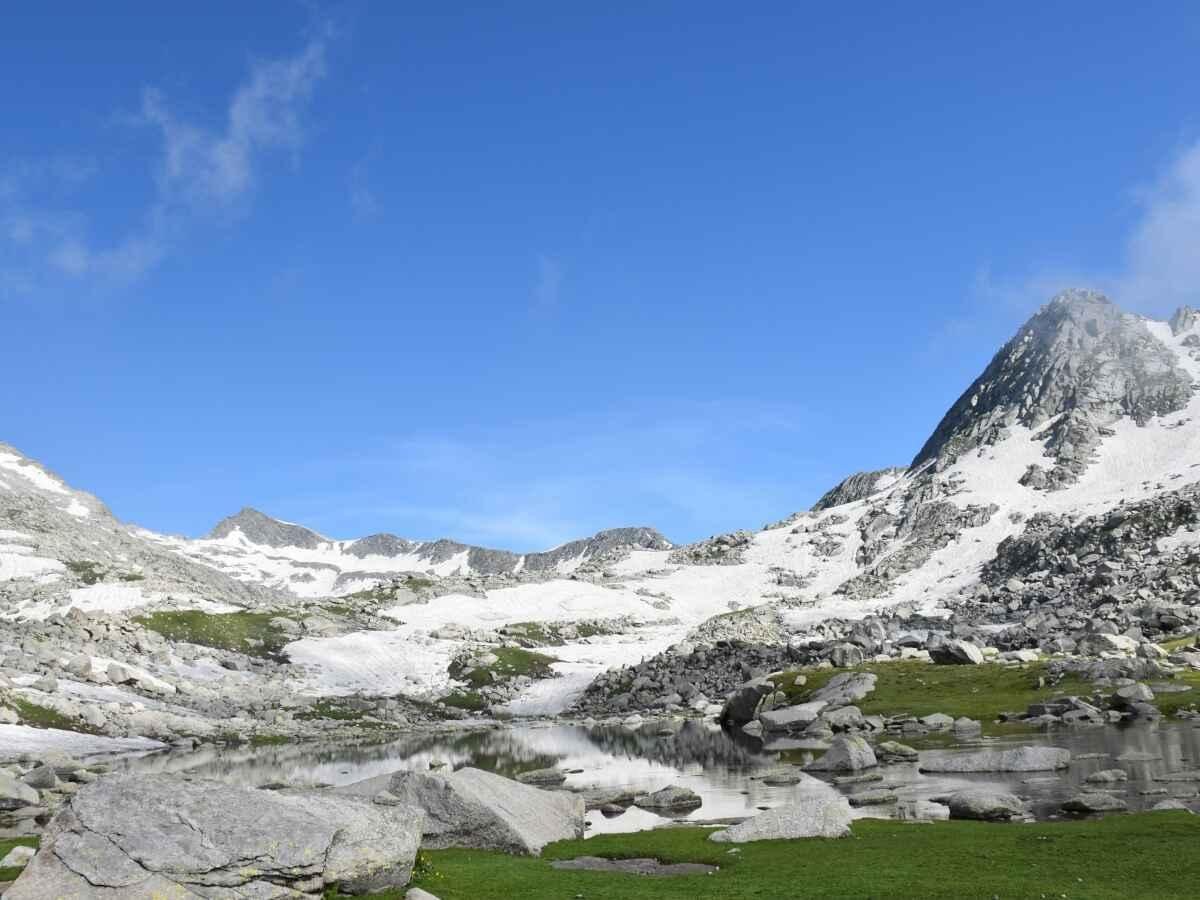
The Sweet Spot of Himalayan Adventure
What if the most breathtaking Himalayan panoramas did not require a month-long expedition or the technical skills of a seasoned mountaineer? The allure of trekking in Himachal Pradesh often conjures images of epic, arduous journeys. Yet, a category of trekking exists that offers the perfect equilibrium of accessible challenge and profound reward. These are the moderate treks—journeys demanding of fitness and spirit, but which repay every drop of sweat with vistas that are nothing short of life-altering. This guide explores five such trekking places in Himachal Pradesh that epitomize this "effort-to-view" philosophy, making them some of the best trekking experiences the region has to offer.
This report delves into five specific adventures: Hampta Pass, Bhrigu Lake, Beas Kund, Kareri Lake, and Triund. Each is a case study in rewarding trekking, offering a nuanced look at their unique challenges, seasonal splendors, and practical planning details. For those wondering about the best time for trekking in Himachal Pradesh, this guide provides month-specific advice for each trail, ensuring adventurers can match their plans to the landscape's peak beauty.
The Hampta Pass Trek: A Journey Across Two Worlds
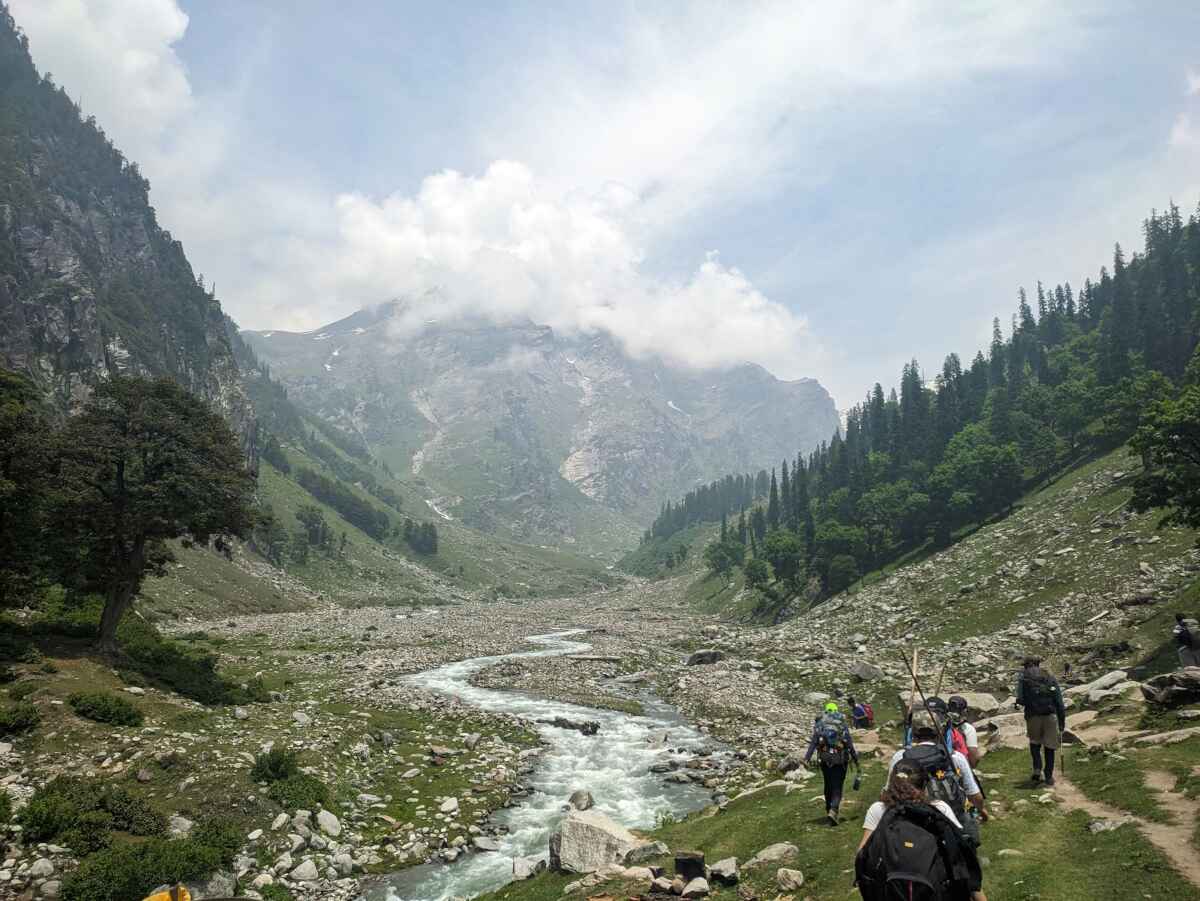
The Hampta Pass trek is the quintessential crossover journey, celebrated for its dramatic and almost surreal transition from one landscape to another. Its primary reward is the visual whiplash of moving from the lush, green, monsoon-soaked valleys of Kullu to the stark, arid, and moon-like terrain of Lahaul and Spiti. This stark contrast in geography and ecology is what makes it one of the most unique and best treks in Himachal Pradesh.
| Trek Vitals | Details |
|---|---|
| Difficulty | Moderate |
| Duration | 5-6 Days |
| Maximum Altitude | ~14,100 ft / 4,270 m |
| Trek Distance | ~25-29 km |
| Best Season | June to September |
The "moderate" difficulty rating of Hampta Pass extends beyond its 14,000-foot altitude; it is intrinsically linked to the trekker's ability to prepare for and endure two completely different climatic zones within a single journey. The trail's signature feature is the dramatic shift from Kullu's vibrant green to Lahaul's barren landscapes. This is not merely a visual change but a fundamental climatological one. The Kullu side, especially during the monsoon months of July and August, is wet, lush, and verdant. Conversely, Lahaul lies in a rain-shadow area, making it an arid, cold, high-altitude desert. Consequently, a trekker must be equipped for both persistent rain on potentially slippery trails and the harsh, windy, and cold conditions of a barren landscape. This need for dual-environment preparedness elevates the trek's complexity, justifying its "moderate" label.
Deconstructing the "Moderate" Challenge
The trek's difficulty is defined by three key factors:
- Rapid Altitude Gain: The journey begins with a significant jump in altitude, from Manali (approx. 6,700 ft) to the Jobra trailhead (approx. 9,000 ft) by vehicle. From there, trekkers ascend to the 14,000-foot pass within just two days of walking. This rapid gain makes individuals more susceptible to Acute Mountain Sickness (AMS) and is a primary reason for its moderate rating.
- Tricky Terrain: The trail presents varied challenges. Trekkers must navigate river crossings, which can be formidable during monsoon , as well as sections of rubble, rocks, and scree on the Spiti side of the pass. The descent from the pass is also noted for being steep and demanding careful negotiation.
- Difficult Exit Points: Once deep into the trek at campsites like Balu ka Ghera or Shea Goru, exiting in an emergency is not straightforward. It requires trekking out of the valley, which adds a layer of commitment and logistical complexity to the journey.
The Journey Day-by-Day
A typical 5-day itinerary unfolds as follows:
- Day 1: Manali to Jobra, Trek to Chikka. After a drive from Manali, the trek begins, ascending through dense forests of pine, oak, and maple to the Chikka campsite.
- Day 2: Chikka to Balu ka Ghera. The trail follows a gradual ascent along the river, eventually opening into vast meadows. The campsite, Balu ka Ghera (meaning "heap of sand"), is a stunning, flat expanse at the base of the final climb.
- Day 3: Balu ka Ghera to Shea Goru via Hampta Pass. The climax of the trek involves a steep ascent to the pass itself. The moment of crossing is unforgettable, with views of Mt. Deo Tibba and Indrasan on one side and the immense, barren Lahaul valley on the other. This is followed by a challenging, steep descent to the Shea Goru campsite on the other side.
- Day 4: Shea Goru to Chhatru, Drive to Chandratal. A downhill trek through the river valley leads to Chhatru. From here, a vehicle takes trekkers to the magnificent Chandratal, the crescent-shaped "Lake of the Moon," a major highlight of the entire journey.
- Day 5: Chandratal to Manali. The journey concludes with a drive back to Manali, often via the Atal Tunnel, completing a spectacular circuit.
Seasonal Splendor: When to Go?
Choosing the right month is crucial for the Hampta Pass experience.
- June: Trekking in June means encountering more snow, especially near the pass. This can make the trek more challenging but offers breathtakingly pristine white landscapes.
- July-August: This is the peak monsoon season and the classic time for this trek. The Kullu valley is at its most vibrant green, with waterfalls and rivers in full flow. Trekkers must be prepared for rain.
- September-October: The post-monsoon window brings clearer skies and crisp views. However, temperatures drop, and early October can bring fresh snowfall, potentially complicating the pass crossing. This period caters to those searching for "trekking in himachal pradesh in september".
The Bhrigu Lake Trek: To the High-Altitude Meadows in a Heartbeat
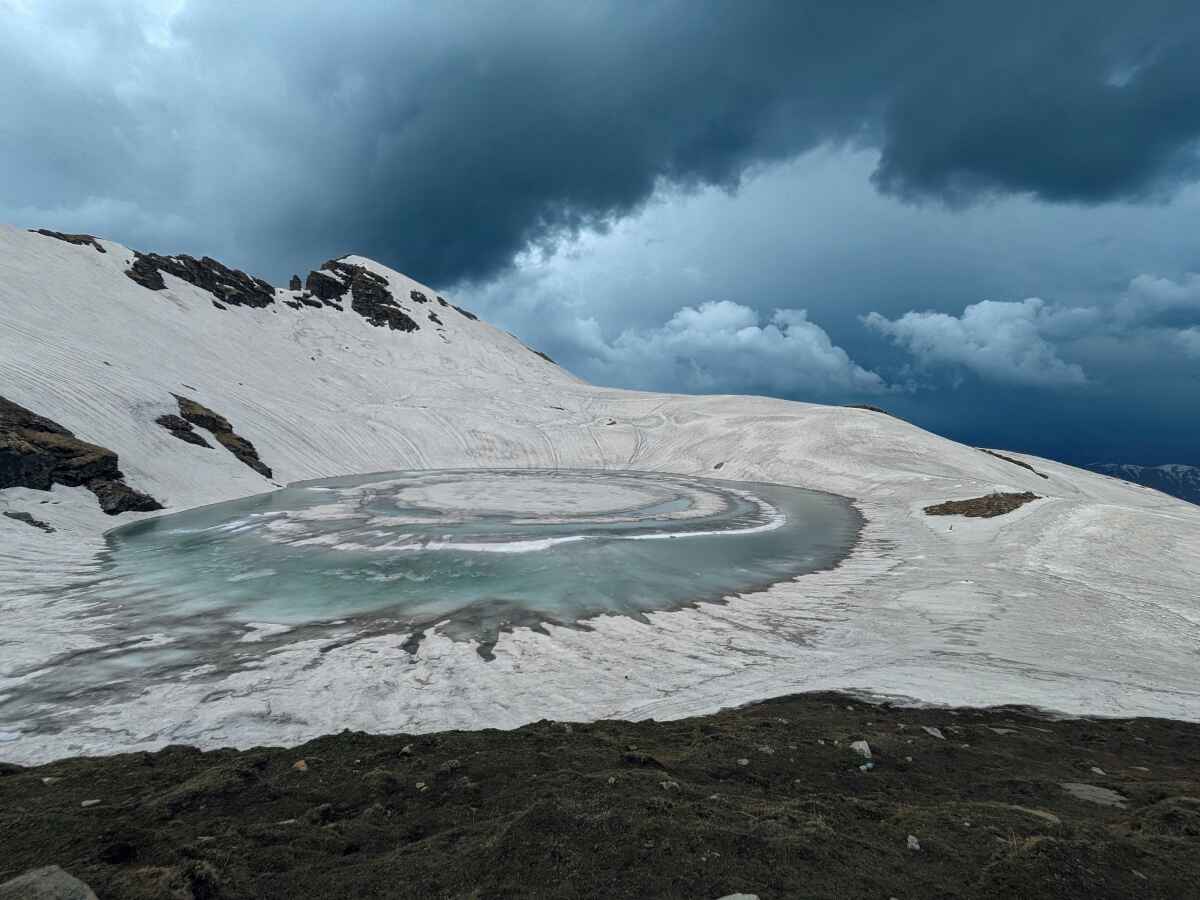
The Bhrigu Lake trek is renowned for delivering maximum reward in minimum time. It presents a rare and exhilarating opportunity to reach a sacred, high-altitude glacial lake at over 14,000 feet and traverse vast alpine meadows, a feature that on most Himalayan treks takes days to reach but here can be experienced on the very first day. This incredible efficiency is its defining appeal.
| Trek Vitals | Details |
|---|---|
| Difficulty | Moderate |
| Duration | 3-4 Days |
| Maximum Altitude | ~14,100 ft / 4,300 m |
| Trek Distance | ~20-25 km |
| Best Season | Mid-June to October |
| Starting Point | Manali (via Gulaba or Vashisht) |
The conflicting difficulty ratings for Bhrigu Lake, which range from "easy-moderate" to "moderate-to-difficult," are not necessarily contradictory. Instead, they reflect differing trekker perspectives on the same fundamental challenge: extremely rapid altitude gain. The primary difficulty of this trek is physiological rather than technical. It demands exceptional endurance to manage the steep, relentless climbs and the heightened risk of AMS that comes with such a swift ascent, more so than it requires advanced mountaineering skills. An experienced trekker who is well-acclimatized might classify it as "easy-moderate," while a very fit individual on their first high-altitude journey may find it "moderate-to-difficult" due to the physiological strain. The trek's difficulty is thus a direct function of one's preparedness for the speed of the ascent.
Deconstructing the "Moderate" Challenge
The trek's moderate rating is based on:
- The Relentless Climb: The trail is known for its steepness. From the Gulaba roadhead, trekkers gain nearly 3,500 feet in altitude over just a couple of kilometers to reach the first campsite. The final push to the lake itself is also steep and can be rugged, with rocky sections or snow patches depending on the season. This sustained effort is a true test of endurance.
- High Altitude in a Short Duration: Reaching an altitude of 14,000 feet on the second or third day of a trek is a significant physiological challenge and places a great deal of stress on the body's ability to acclimatize. This is the primary reason it is considered more than just an "easy" trek.
Variable Conditions: The trail can be challenging underfoot, with rocky, muddy, and slippery sections, particularly during the monsoon. In the early season (May-June), lingering snow patches can make the final ascent to the lake particularly tricky.
The Journey Day-by-Day
A common 3-day itinerary from Gulaba unfolds as follows:
- Day 1: Manali to Gulaba (Drive), Trek to Rola Kholi. After a short drive from Manali, the trek begins. Almost immediately, the trail enters spectacular alpine meadows, a unique feature of this trek. The campsite at Rola Kholi offers sweeping views of the Kullu Valley and prominent peaks like Hanuman Tibba and the Seven Sisters.
- Day 2: Rola Kholi to Bhrigu Lake and Back. This is the summit day, requiring an early start. The trail involves a steep ascent over rocky terrain, often with snow patches to navigate. The destination is the pristine and sacred Bhrigu Lake, named after the sage Maharishi Bhrigu. As camping is not permitted at the lake, trekkers must return to the Rola Kholi campsite for the night.
- Day 3: Rola Kholi to Gulaba, Drive to Manali. The final day involves a descent back to the roadhead, offering one last chance to enjoy the magnificent meadows before driving back to Manali.
Seasonal Splendor: Snow, Green, or Gold?
The visual character of the Bhrigu Lake trek changes dramatically with the seasons.
- June: This is the ideal time for those who wish to experience snow. The vast meadows will be a stunning canvas of green and white, and the lake itself may be partially frozen, creating a truly magical landscape.
- July-September: During the monsoon, the meadows are at their most verdant and lush, carpeted with a vibrant array of wildflowers. Trekkers should be prepared for rain and misty, atmospheric conditions.
September-October: The post-monsoon autumn window provides the clearest skies and the most stable weather. The meadows take on a golden hue, and the views of the Pir Panjal and Dhauladhar ranges are exceptionally crisp and breathtaking.
The Beas Kund Trek: At the Source of a Mighty River
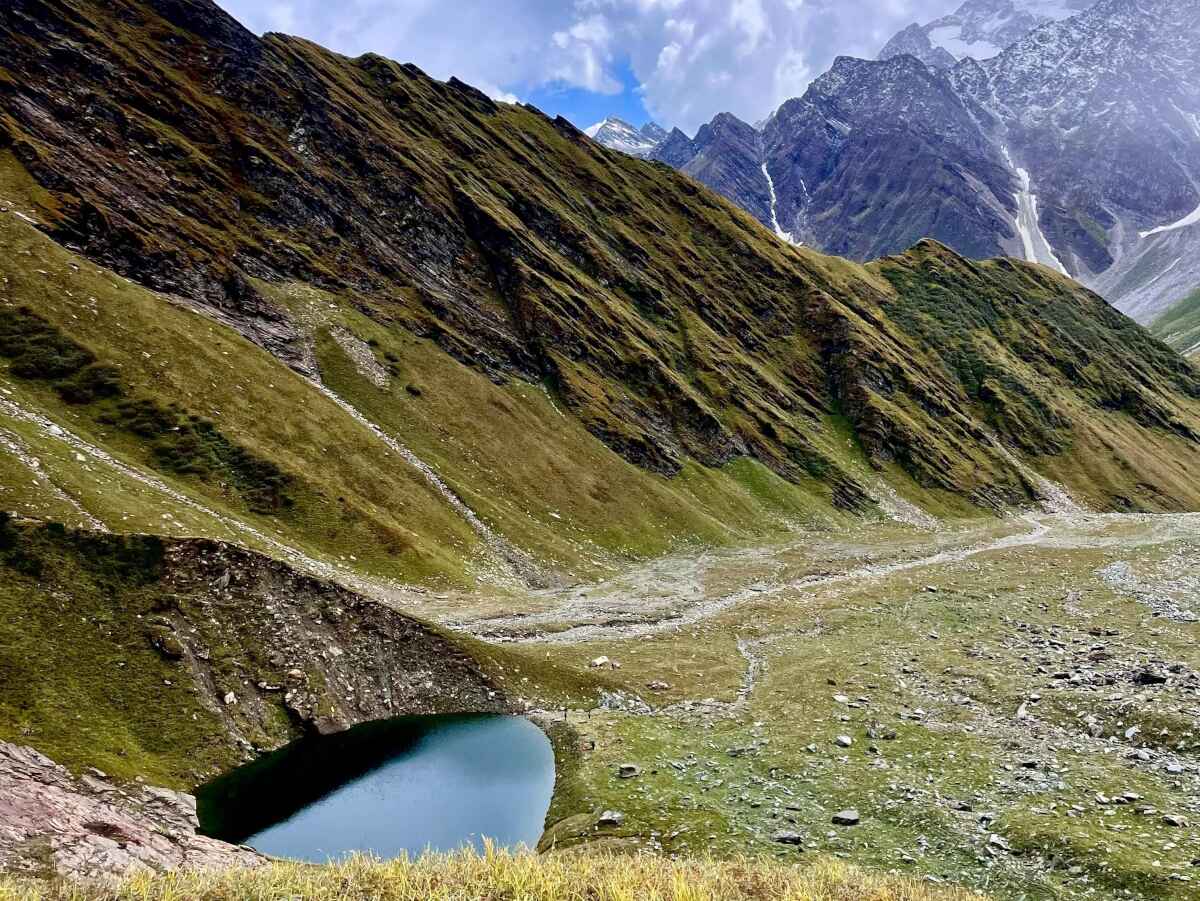
This trek is both a geographical and mythological pilgrimage, leading adventurers to the very source of the mighty Beas River, a glacial lake believed to be the ancient bathing site of the sage Vyas. The ultimate scenic payoff is the breathtaking natural amphitheater formed by a ring of towering Himalayan peaks that surround the Kund, including the majestic Hanuman Tibba, Friendship Peak, and Deo Tibba.
| Trek Vitals | Details |
|---|---|
| Difficulty | Easy to Moderate |
| Duration | 3-4 Days |
| Maximum Altitude | ~12,772 ft / 3,890 m |
| Trek Distance | ~16-18 km |
| Best Season | May to October |
| Starting Point | Manali (via Solang Valley / Dhundi) |
The "easy-to-moderate" rating of the Beas Kund trek can be deceptive because its difficulty is not distributed evenly. The first couple of days feature a gentle, picturesque walk along the river, which can lull inexperienced trekkers into a false sense of security. The genuine "moderate" challenge is concentrated on the final day's ascent to the Kund. This section involves a steep, high-altitude climb over a landscape filled with moraine and boulders, demanding a significant reserve of energy and a good level of fitness. The easy start can lead to poor pacing, making the final push feel overwhelming. Success on this trek often hinges on understanding this back-loaded difficulty and conserving energy for the crucial summit day.
Deconstructing the "Moderate" Challenge
The key challenges that define this trek are:
- The Summit Day Push: The ascent from the final campsite to Beas Kund, often referred to as the "Lady Leg" section, is steep and relentless, forming the crux of the entire trek.
- Altitude Gain: While the maximum altitude is lower than Bhrigu Lake, the trek still involves a rapid gain to over 12,000 feet, which carries a tangible risk of AMS if not managed with proper acclimatization.
- Terrain Variation: The initial trail is well-defined and easy to follow. However, the final approach to the lake requires navigating boulders, glacial moraine, and streams, which demands careful footing and balance.
Monsoon Weather: As a popular monsoon trek, especially from July to September, trekkers must be prepared for rain, which can lead to slushy and slippery trails.
The Journey Day-by-Day
A classic 3-day itinerary for the trek is as follows:
- Day 1: Manali to Dhundi (Drive), Trek to Bakarthach. The journey begins with a scenic drive through the adventure hub of Solang Valley to the Dhundi trailhead. The trek follows the Beas River upstream, passing through beautiful meadows dotted with wildflowers and groves of Bhoj Patra (Birch) trees. The night is spent camping at Bakarthach, with views of the Seven Sisters peaks.
- Day 2: Bakarthach to Beas Kund and Back. This is the main day of the trek, involving a steep ascent over moraine and boulders to reach the stunning emerald lake at the river's source. The reward is a spectacular 360-degree panorama of towering, snow-clad mountains. Trekkers return to the Bakarthach campsite for the night.
- Day 3: Bakarthach to Dhundi, Drive to Manali. The final day consists of a relatively easy descent back to the road at Dhundi, followed by a drive back to Manali.
Seasonal Splendor: When to Witness the Source?
The character of the Beas Kund trek varies significantly with the seasons.
- May-June: This period is ideal for those who want to experience snow on the higher reaches of the trek and around the lake itself, making for dramatic landscapes. This directly addresses search interest for "trekking in himachal pradesh in may" and "june".
- July-September: During the monsoon, the landscape is transformed into a lush, vibrant green, with the meadows of Dhundi and Bakarthach in full bloom. This is considered a peak time for the trek, despite the likelihood of rain.
- September-October: The post-monsoon autumn season offers crystal-clear skies, providing the sharpest and most spectacular panoramic views of the surrounding Himalayan giants.
The Kareri Lake Trek: A Tranquil Journey in the Dhauladhars

The Kareri Lake trek offers a serene and relatively offbeat alternative to the more frequented trails around Manali. Situated in the majestic Dhauladhar range, its primary reward is the pristine, tranquil glacial lake, which remains frozen for several months of the year. The presence of an ancient Shiva temple on a hilltop overlooking the lake adds a palpable spiritual dimension to this beautiful journey.
| Trek Vitals | Details |
|---|---|
| Difficulty | Easy to Moderate |
| Duration | 3-4 Days |
| Maximum Altitude | ~9,626 ft / 2,934 m |
| Trek Distance | ~26 km (round trip) |
| Best Season | May-June & September-November |
| Starting Point | Dharamshala / McLeod Ganj (via Kareri Village) |
The "moderate" rating for Kareri Lake stems not from extreme altitude but from the raw and authentic nature of its trail. Compared to more commercialized treks with well-paved paths, the route to Kareri Lake is less manicured and presents a more rugged challenge. The trail involves multiple crossings of the Nyund nallah, some on makeshift bridges and others requiring careful navigation over riverine boulders. Trekkers must also contend with rocky patches, muddy sections, and dense forest terrain that demand constant attention and balance. This is in contrast to treks like Triund, which feature a more defined and established path. Therefore, the difficulty of Kareri Lake lies not just in its statistics but in the quality of the terrain itself. It requires more than just cardiovascular fitness; it demands resilience, adaptability, and a genuine spirit of adventure to navigate its wilder character.
Deconstructing the "Moderate" Challenge
The trek's moderate nature is defined by:
- Varied and Rugged Terrain: The trail is in a constant state of flux, shifting from forest paths covered in slippery pine needles to rocky riverbeds and potentially muddy tracks, especially after rain. This variability is more physically and mentally taxing than a uniform trail.
- River Crossings: A key feature and challenge of the trek is the necessity of crossing the Nyund nallah (or Fund river) multiple times. These crossings can be tricky, particularly when water levels are higher.
Steep Sections: The trek includes significant steep ascents and descents. The climb to the lake and the subsequent descent back to the village of Ghera are particularly demanding on the knees and require a good level of stamina.
The Journey Day-by-Day
A typical 3-day itinerary is structured as follows:
- Day 1: Dharamshala to Kareri Village (Drive), Trek to Reoti/Liyoti. A scenic drive from Dharamshala leads to the base village of Kareri. From here, the trek begins, following a river through dense pine and oak forests. The night is spent camping in the beautiful alpine meadow of Reoti.
- Day 2: Reoti to Kareri Lake and Back. The trail becomes progressively rockier as it ascends alongside the nallah. As the tree line recedes, the massive peaks of the Dhauladhar range dominate the skyline. Upon reaching the stunning elliptical lake, trekkers can explore the Shiva temple and absorb the incredible views towards Minkiani and Baleni passes before returning to the Reoti campsite.
- Day 3: Reoti to Kareri Village, Drive to Dharamshala. The final day involves a relatively straightforward descent back to Kareri village, concluding the trek before the drive back to Dharamshala.
Seasonal Splendor: A Year in the Dhauladhars
The Kareri Lake trek offers a different experience in every season.
- March-April: In early spring, snow is often still present at the lake, while the lower sections of the trail are clear and accessible.
- May-June: This is the peak summer season, characterized by lush greenery, blooming wildflowers, and pleasant trekking weather, making it an ideal time to visit.
- September-November: The post-monsoon autumn period offers fantastic visibility with clear skies and stable weather, although the nights become progressively colder.
- December-March: For the more adventurous, winter transforms the trek into a snowy wonderland. The lake freezes over completely, and the trail is covered in heavy snow, making it a challenging but uniquely beautiful snow trek. This directly caters to those searching for "trekking in himachal pradesh in december" or "january".
The Triund Trek: The Quintessential Himalayan Balcony
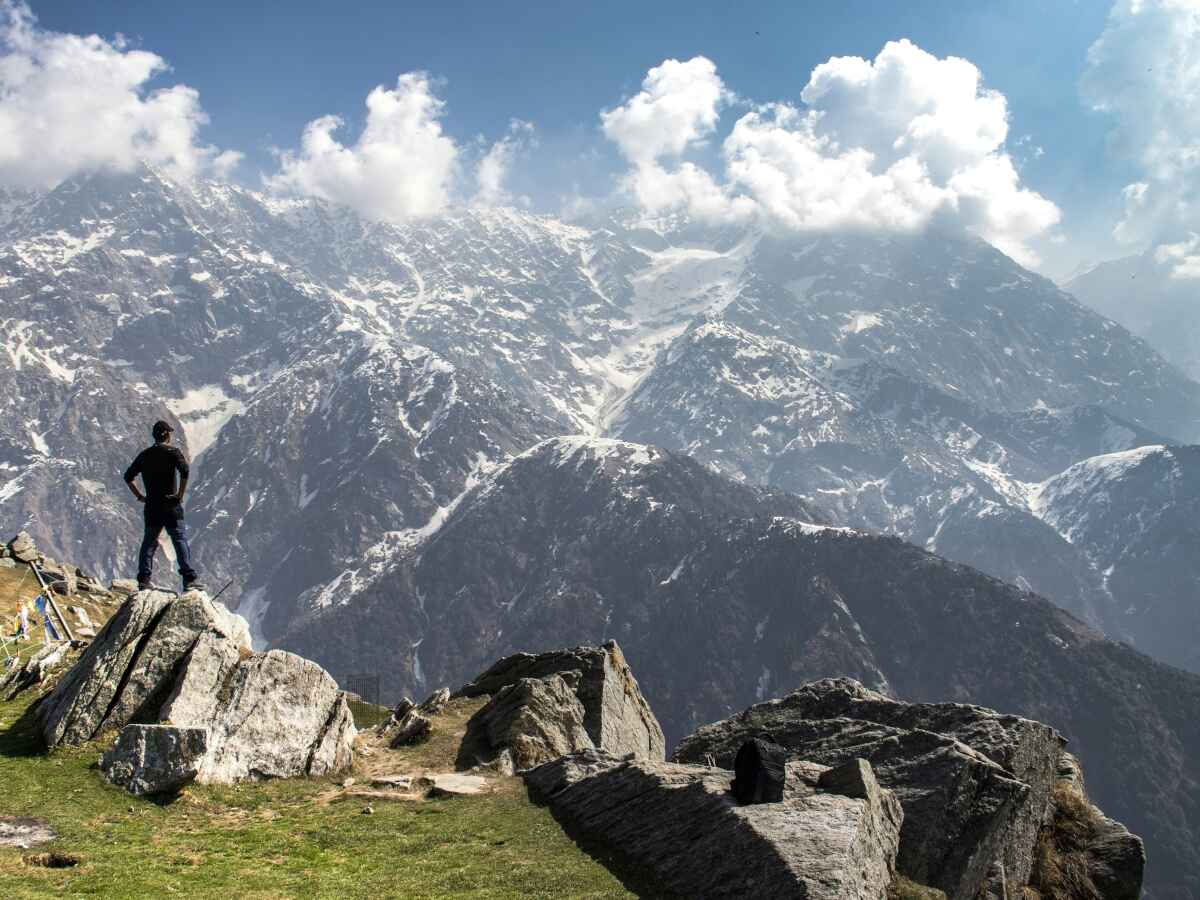
The Triund trek is arguably the most popular and accessible trek on this list, often hailed as the perfect introduction to Himalayan trekking. It is famous for what can only be described as a "balcony" view—an unparalleled, in-your-face panorama of the magnificent snow-covered Dhauladhar range. It offers a taste of high-altitude camping and spectacular sunsets without requiring a multi-day commitment, making it an ideal weekend adventure.
| Trek Vitals | Details |
|---|---|
| Difficulty | Easy to Moderate |
| Duration | 2 Days / 1 Night |
| Maximum Altitude | ~9,350 ft / 2,850 m |
| Trek Distance | ~9 km (one way) |
| Best Season | March-June & September-December |
| Starting Point | McLeod Ganj / Dharamkot / Gallu Devi Temple |
The "moderate" character of the Triund trek is perfectly encapsulated in its final kilometer, a section famously known as the "22 Curves". While much of the trek is a manageable walk, this short but brutally steep final stretch serves as a microcosm of the entire trekking experience. It rigorously tests a trekker's endurance, rewards their perseverance with the spectacular view from the Triund ridge, and teaches beginners the crucial lessons of pacing and mental fortitude. It is this specific element that elevates Triund from a simple uphill walk to a genuine trek. The notoriety of this section, evidenced by its popular name, highlights its role as the definitive challenge. For a first-timer, conquering these curves is a significant physical and mental achievement, making the overall experience feel "moderate" despite the trek's relatively short distance and lower altitude.
Deconstructing the "Moderate" Challenge
The factors that contribute to its moderate difficulty include:
- The 22 Curves: The final stretch consists of a series of steep switchbacks that present a significant cardiovascular challenge, particularly for those unaccustomed to sustained inclines.
- Slippery Sections: The trail, though well-defined, can have rocky and slippery patches where good trekking shoes and careful footing are essential.
Sun Exposure: The initial half of the trek is largely exposed to the sun. If started late in the day, the harsh mountain sun can be draining and add to the trek's difficulty.
The Journey Day-by-Day
The classic 2-day itinerary is as follows:
- Day 1: McLeod Ganj to Triund. The trek typically starts from Dharamkot or the Gallu Devi Temple, winding through beautiful forests of oak and rhododendron. Trekkers often stop at the Magic View Café, located around the halfway point. The final, challenging ascent of the "22 Curves" leads to the spectacular Triund ridge. After setting up camp, the reward is a legendary sunset over the Kangra valley.
Day 2: Triund to McLeod Ganj. The morning offers stunning sunrise views on the Dhauladhar peaks. After breakfast, the descent begins, which is considerably quicker than the climb. Trekkers can choose to descend via the Bhagsu waterfall route for a different perspective.
Seasonal Splendor: Triund Through the Year
Triund offers a different personality in every season.
- March-June (Spring/Summer): This is the most popular time to trek. The weather is pleasant, the trails are clear, and the rhododendrons are in full bloom. However, this is also the most crowded season.
- July-August (Monsoon): This period is generally avoided due to heavy rainfall, which makes the trails slippery and increases the risk of landslides.
- September-November (Autumn): Many consider this the best season for Triund. The post-monsoon air is crisp and clear, offering the sharpest, most stunning views of the Dhauladhar range.
December-February (Winter): The trek transforms into a magical snow adventure. The trail is blanketed in snow, making it more challenging but also incredibly serene and beautiful. This is an excellent option for those searching for "trekking in himachal pradesh in december".
Planning Your Perfect Moderate Trek: A Comparative Guide & Practical Toolkit
Moving from inspiration to action requires practical knowledge. This section synthesizes the critical planning details for these five treks, addressing key search interests like "trekking in himachal pradesh packages," "trekking groups in himachal pradesh," and the specifics of "trekking and camping in himachal pradesh".
Choosing Your Adventure: A Comparative Analysis
The "best" trek is subjective and depends entirely on personal priorities such as available time, fitness level, and desired scenery. This table provides a comparative overview to help in the decision-making process.
| Trek Name | Difficulty (Qualifier) | Duration | Max Altitude | Best Season | Signature View | Best For |
|---|---|---|---|---|---|---|
| Hampta Pass | Moderate (Rapid Ascent & Climate Change) | 5-6 Days | ~14,100 ft | Jun-Sep | Kullu-to-Spiti Crossover | Dramatic landscape diversity and a longer adventure. |
| Bhrigu Lake | Moderate (Intense, Rapid Ascent) | 3-4 Days | ~14,100 ft | Jun-Oct | High-Altitude Glacial Lake & Meadows | A quick, intense challenge with an immediate high-altitude reward. |
| Beas Kund | Easy-Moderate (Back-loaded Difficulty) | 3-4 Days | ~12,772 ft | May-Oct | Amphitheater of Himalayan Peaks | A mythological journey with stunning peak views, great for fit beginners. |
| Kareri Lake | Easy-Moderate (Rugged, Authentic Trail) | 3-4 Days | ~9,626 ft | May-Jun, Sep-Nov | Serene Glacial Lake in Dhauladhars | A quieter, more authentic trail experience with a tranquil destination. |
| Triund | Easy-Moderate (Steep Final Kilometer) | 2 Days | ~9,350 ft | Mar-Jun, Sep-Dec | "Balcony" View of the Dhauladhars | The perfect first Himalayan trek; a short commitment for a massive scenic payoff. |
Navigating Trekking Packages and Groups
For those who prefer an organized experience, numerous trekking operators in Manali and McLeod Ganj offer packages. A typical package generally includes the services of a guide, camping equipment (tents, sleeping bags), all meals during the trek, and necessary permits. Common exclusions to be aware of are transportation to and from the base camp, personal expenses, tips for the crew, and fees for offloading personal backpacks. When selecting an operator, it is advisable to look for companies that employ certified guides and provide essential safety equipment, such as oxygen cylinders and comprehensive first-aid kits.
The Art of Camping in Himachal
Camping is an integral part of the Himalayan trekking experience. On these treks, accommodation is typically in dome tents on a twin or triple-sharing basis. The campsites are often located in stunning meadows or near serene streams, offering opportunities for stargazing and deep immersion in nature. Many trekking packages include evening bonfires, which provide warmth and a chance for camaraderie with fellow trekkers. Toilet facilities are basic, usually consisting of dry pit tents set up at a distance from the main campsite.
Essential Toolkit for the Moderate Trekker
- Fitness: A "moderate" rating should not be underestimated. All these treks require a solid baseline of cardiovascular fitness. A good benchmark, as suggested by several trekking organizations, is the ability to jog 5 km in 35-45 minutes.
- Acclimatization: This is crucial, especially for treks with rapid ascents like Bhrigu Lake and Hampta Pass. It is highly recommended to arrive at the base town (Manali or McLeod Ganj) at least one day before the trek begins to allow the body to adjust to the altitude.
Gear: Proper gear is essential for safety and comfort. The non-negotiable items include a pair of well-broken-in trekking shoes with good grip, layered clothing (thermals, fleece, and a waterproof outer layer), sun protection (sunglasses, cap, sunscreen), a headlamp, reusable water bottles, and a personal medical kit.
Ultimately, the perfect Himalayan adventure is well within reach for anyone with a spirit of adventure and a willingness to prepare. These five treks prove that the most profound experiences are not always found at the end of the longest road, but often at the top of a well-chosen, moderately challenging trail.
